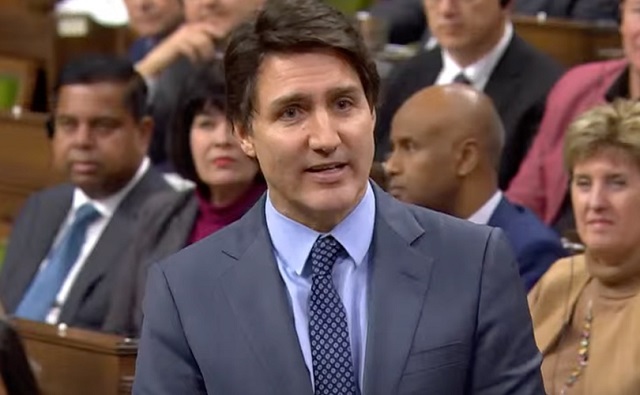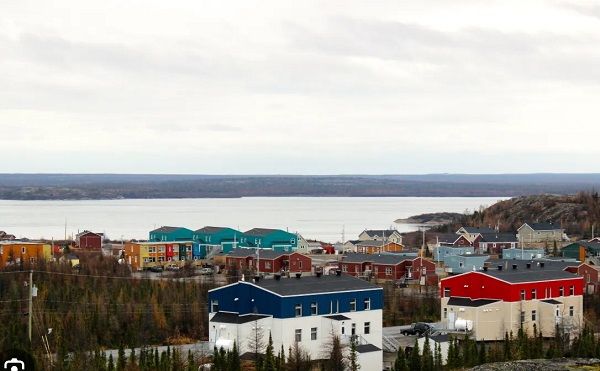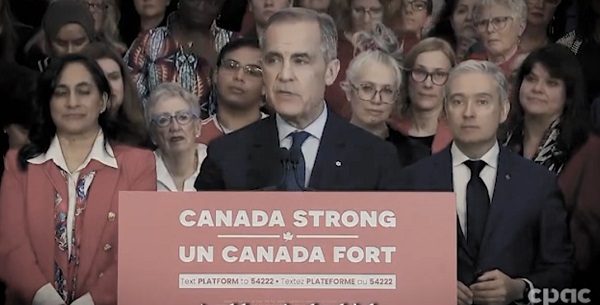National
Trudeau forced to admit ‘Christmas is not racist’ after gov’t report suggesting it is

From LifeSiteNews
The report claimed that holidays such as Christmas and Easter are forms of discrimination and religious intolerance and observing the birth of Jesus Christ is ‘an obvious example’ of a type of religious bias that is rooted in colonialism
Canadian MPs roundly condemned a report from the Canadian Human Rights Commission (CHRC) arguing that Christmas was racist.
On November 29, Bloc Québécois leader Yves-François Blanchet challenged the CHRC report which claimed that those who celebrate Christmas are exhibiting intolerance and perpetuating so-called “settler colonialism” and forced even Prime Minister Justin Trudeau to admit that the holiday is not racist.
“Just because you laugh doesn’t mean it’s funny,” Blanchet told the House of Commons. “According to the Canadian Human Rights Commission the simple celebration of Christmas – the tree, the family, the music, the gifts – is systemic racism. I wonder if good old Santa Claus is racist. I wonder if snow has become racist.”
Blanchet pressed Trudeau to explain the document, saying, “Is Christmas racist?”
“Obviously Christmas is not racist,” Trudeau responded.
“I am welcoming a few dozen Québecers from immigrant backgrounds to celebrate Christmas in my riding in a few days,” Blanchet continued. “Should I cancel because, according to the Canadian Human Rights Commission, celebrating Christmas is racist? That is the question I am asking.”
“No,” Trudeau replied. “We have to celebrate everything, Christmas, Hanukkah, all the different festivals.”
Conservative Party Leader Pierre Poilievre also joined in the discussion, saying, “Allow me to be the first of the season to wish everybody a merry Christmas. We love our great Canadian traditions including Christmas.”
As LifeSiteNews previously reported, on October 23, 2023, the CHRC published “Discussion Paper On Religious Intolerance.” It characterized the celebration of holidays such as Christmas and Easter as forms of discrimination and religious intolerance.
The CHRC said that observing the birth of Jesus Christ is “an obvious example” of a type of religious bias that is rooted in colonialism.
“Discrimination against religious minorities in Canada is grounded in Canada’s history of colonialism,” reads the Commission’s paper.
Despite the mainstream push to switch to the term “Happy Holidays” in lieu of “Merry Christmas,” a Leger poll from December 2022 found that the overwhelming majority of non-Christian Canadians are content with being greeted by the words “Merry Christmas” during the season of Advent.
When the non-Christians were asked if they were “Offended when people greet me with ‘Merry Christmas’,” 92 percent said no, with only eight percent reporting they felt offended.
The CHRC is an independent federal institution created in 1977 that oversees holding up Canada’s human rights laws.
The CHRC claims that the history of holidays “manifests itself in present day systemic religious discrimination. An obvious example is statutory holidays in Canada.”
“Statutory holidays related to Christianity including Christmas and Easter are the only Canadian statutory holidays linked to religious holy days,” it said.
“As a result non-Christians may need to request special accommodation to observe their holy days.”
The European settlers who came to Canada, from France and then later from what is the modern-day United Kingdom, were Christian and included missionaries who came to try to spread the faith to the local indigenous populations.
Canada has observed Christmas since 1641, well before its official founding, according to some historical records. Despite this, the CHRC said that the nation’s “history with religious intolerance is deeply rooted in our identity as a settler colonial state.”
In 2021, a federal court directive mandated that all references to Christmas holidays be removed from all court calendars, however, this directive did not come from a complaint but instead was an internal decision.
2025 Federal Election
POLL: Canadians want spending cuts

 By Gage Haubrich
By Gage Haubrich
The Canadian Taxpayers Federation released Leger polling showing Canadians want the federal government to cut spending and shrink the size and cost of the bureaucracy.
“The poll shows most Canadians want the federal government to cut spending,” said Gage Haubrich, CTF Prairie Director. “Canadians know they pay too much tax because the government wastes too much money.”
Between 2019 and 2024, federal government spending increased 26 per cent even after accounting for inflation. Leger asked Canadians what they think should happen to federal government spending in the next five years. Results of the poll show:
- 43 per cent say reduce spending
- 20 per cent say increase spending
- 16 per cent say maintain spending
- 20 per cent don’t know
The federal government added 108,000 bureaucrats and increased the cost of the bureaucracy 73 per cent since 2016. Leger asked Canadians what they think should happen to the size and cost of the federal bureaucracy. Results of the poll show:
- 53 per cent say reduce
- 24 per cent say maintain
- 4 per cent say increase
- 19 per cent don’t know
Liberal Leader Mark Carney promised to “balance the operating budget in three years.” Leger asked Canadians if they believed Carney’s promise to balance the budget. Results of the poll show:
- 58 per cent are skeptical
- 32 per cent are confident
- 10 per cent don’t know
“Any politician that wants to fix the budget and cut taxes will need to shrink the size and cost of Ottawa’s bloated bureaucracy,” Haubrich said. “The polls show Canadians want to put the federal government on a diet and they won’t trust promises about balancing the budget unless politicians present credible plans.”
2025 Federal Election
How Canada’s Mainstream Media Lost the Public Trust

Breaking: CBC News admits that host Rosemary Barton was wrong on April 16 when she said “remains of indigenous children” have been discovered.
Call it the Panic Election. From The Handmaid’s Tale to Quebec alienation to plastic straws, the dynamic is citizens being stampeded in a brief six weeks by Big Brother. (There’s no Big Sister. That would mess with the narrative.) Prompting Covid Part Deux from the Laurentian media scolds.
Nowhere is this panic more keen than among aging Boomers who’ve pronounced themselves willing to ignore a decade of Justin Trudeau’s clumsy, unethical and sometimes criminal behaviour in the wake of Big Bad Trump. Even the threat of losing the country’s AAA credit rating can’t sway them from full-throated panic about being the 51st state.
The 51st state gambit is the window dressing. The real Trump panic is over him exposing the inadequacies of a Canadian society penetrated by China, dominated by globalist fanatics and more indebted every day. Specifically, Trump labelled Canadians defence dead-beats and entitled snobs who’d be crazy not to join the U.S. The insulting Trump framing has been a lifeline to those most recently in office— Liberals— to point at the Big Bad Wolf outside the door rather than the Frozen Venezuela inside its walls.
Integral to this panic is the role of Canada’s legacy media, a self-serving caste saved from bankruptcy (for now) by generous wads of public money. The 416/613 bubble ponies operate as if it were still 1985, not 2025. They’ve managed to preserve their status while society changed around them. For instance, CBC’s flagship At Issue panel features three people from Toronto and a fourth from Montreal.
It has worked perfectly in Boomer Canada. Until this past week, when the media guardians finally lost the plot. The combination of TV panel hubris and the incompetence of the Elections Commission exposed an industry more interesting in protecting its own turf than protecting the truth.
The meltdown was the notion that conservative social media— with its intrusive reporters and tabloid tactics— had no place in their sandbox. This hissy fit came after Wednesday’s French debate. Members of Rebel News, True North and other outfits dominated the party leaders’ scrums with obtrusive questions about Mark Carney’s opinions on same-sex sports and what constitutes a woman— questions the French moderator had neglected to ask.

For legacy reporters and hosts who take it as given that they be allowed the front pew this was an affront to their status. As purveyors of the one true political religion the talking heads on CBC, CTV and Global began speaking of “so-called journalists” and “far-right” intruders elbowing into their territory. Their resentment was all-consuming.
This resentment spilled into Debate Night Two when a shouting match ensued in the press room. A CBC source claimed (incorrectly) that Rebel Media leader Ezra Levant had been barred from the press room. A writer from the Hill Times screamed at members of their raucous rivals. The carefully chose panelists suggested that these outfits were funded by dark right-wing sources.
Before the debate had ended Elections Commission organizers— reportedly goaded by the Liberals— called off the post-debate scrum citing “safety” issues that seemingly included a Rebel reporter conducting a hostile walking interview with a furious Liberal official. This unleashed another torrent of Media Party vitriol about its position as the keepers of Canadian journalism.

In a show of irony, these complaints about right-wing misinformation came from people whose livelihood is dependent on Liberal slush funds or whose organizations have accepted government funds to stave off bankruptcy or whose union is an active shill for non-Conservative parties. The conflicts are never mentioned in the unctuous festival of privilege.
What makes this rearguard action against new media risible was the 2024 U.S. election where Donald Trump acknowledged the new day and rode the support of non-traditional media back to the presidency. His shunning of the legacy networks and hallowed print brands heralded a new reality in American elections. Poilievre has struggled to find this community in Canada, but for those with eyes it remains the future of disseminating political thought.
A perfect example of alternative media scooping the tenured mob on Parliament Hill has been the sterling work on China by Sam Cooper, a former Global employee who has independently demonstrated the ties between Chinese criminal gangs and the Canadian political structure going back to the 1980s. Working with others outside the grid he’s shown the scandal of a Liberal candidate urging Chinese Canadian voters to reap a bounty for turning his Conservative opponent to the Chinese Communist Party. A disgrace that Carney has forgiven.
Predictably Cooper’s work and the independent story by two retired RCMP investigators who implicated nine Liberal cabinet members in compliance with the Chinese communists has gotten the ‘tish-tish” from the Laurentian elites. Like the Democrats who buried the Hunter Biden laptop story to save his father in the dying days of the 2020 U.S. election the poodle media hope to delay the truths about China long enough to get the compliant Carney over the finish line.
For contrast to how it was— and could be— one only had to witness the moderator performance of journalist Steve Paikin of TVO. Largely unknown outside Ontario, Paikin overcame the skepticism of Westerners by playing it straight down the middle. Such was his honest-broker performance that Poilievre was heard telling him after the debate that he had no idea how Paikin might vote. (Ed. note: Paikin is a former colleague and longtime friend.) In other words, it’s still possible.
It’s a cliché that this election is a hinge point for Canada. Will it face itself in the mirror or indulge in more denialism about its true self? No wonder unaffiliated journalists joke that their stories today will be the lead on mainstream media in three months. Carney has promised to continue bribing the mainstream media, but their day is done. It’s simply a matter of fixing a date for the next panic.
Bruce Dowbiggin @dowbboy is the editor of Not The Public Broadcaster A two-time winner of the Gemini Award as Canada’s top television sports broadcaster. His new book Deal With It: The Trades That Stunned The NHL And Changed Hockey is now available on Amazon. Inexact Science: The Six Most Compelling Draft Years In NHL History, his previous book with his son Evan, was voted the seventh-best professional hockey book of all time by bookauthority.org. You can see all his books at brucedowbigginbooks.ca.
-

 Alberta2 days ago
Alberta2 days agoProvince to expand services provided by Alberta Sheriffs: New policing option for municipalities
-

 2025 Federal Election2 days ago
2025 Federal Election2 days agoCSIS Warned Beijing Would Brand Conservatives as Trumpian. Now Carney’s Campaign Is Doing It.
-

 Bruce Dowbiggin2 days ago
Bruce Dowbiggin2 days agoIs HNIC Ready For The Winnipeg Jets To Be Canada’s Heroes?
-

 Alberta2 days ago
Alberta2 days agoMade in Alberta! Province makes it easier to support local products with Buy Local program
-

 2025 Federal Election2 days ago
2025 Federal Election2 days agoNo Matter The Winner – My Canada Is Gone
-

 Health2 days ago
Health2 days agoHorrific and Deadly Effects of Antidepressants
-

 2025 Federal Election2 days ago
2025 Federal Election2 days agoCampaign 2025 : The Liberal Costed Platform – Taxpayer Funded Fiction
-

 2025 Federal Election2 days ago
2025 Federal Election2 days agoA Perfect Storm of Corruption, Foreign Interference, and National Security Failures
